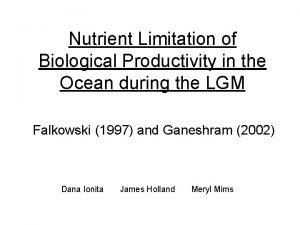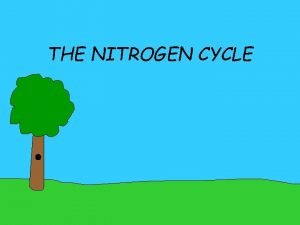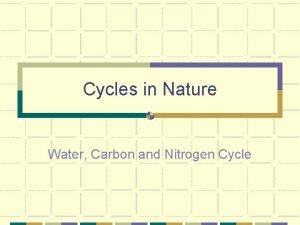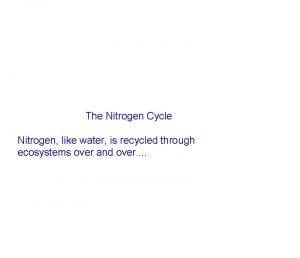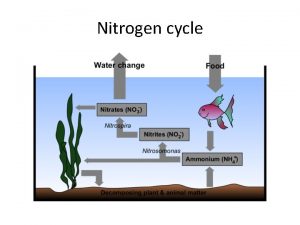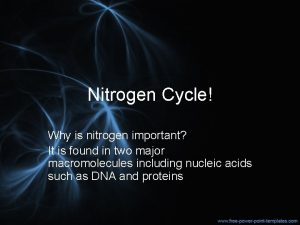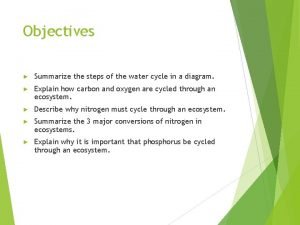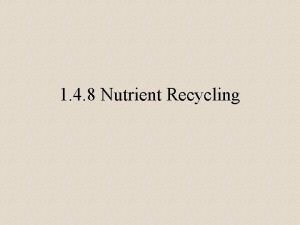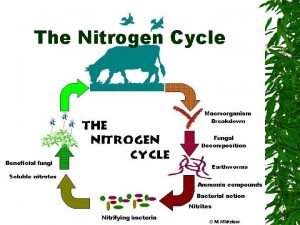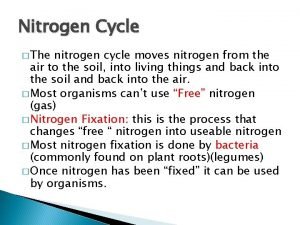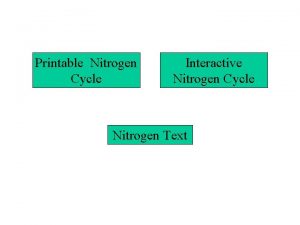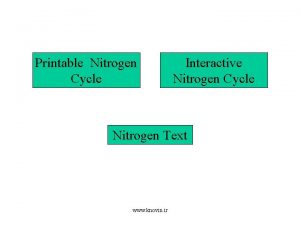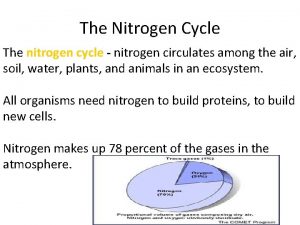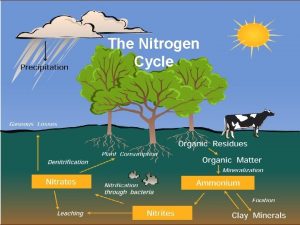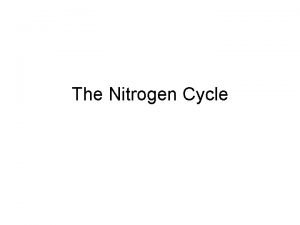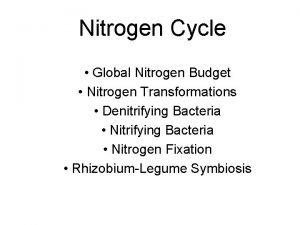Nitrogen Cycle What id Nitrogen Nitrogen is a











- Slides: 11

Nitrogen Cycle

What id Nitrogen? Nitrogen is a chemical element with symbol N and atomic number 7. It is the lightest pnictogen and at room temperature, it is a transparent, odorless diatomic gas.

Why is it important? Nitrogen is an essential component of DNA, RNA, and proteins, the building blocks of life. Although the majority of the air we breathe is N 2, most of the nitrogen in the atmosphere is unavailable for use by organisms. This is because the strong triple bond between the N atoms in N 2 molecules makes it relatively inert, or unreactive, whereas organisms need reactive nitrogen to be able to incorporate it into cells. In order for plants and animals to be able to use nitrogen, N 2 gas must first be converted to more a chemically available form such as ammonium (NH 4+), nitrate (NO 3 -), or organic nitrogen (e. g. , urea, which has the formula (NH 2)2 CO). The inert nature of N 2 means that biologically available nitrogen is often in short supply in natural ecosystems, limiting plant growth.

How does the Nitrogen cycle work?

Five main processes cycle nitrogen through the biosphere, atmosphere, and geosphere: nitrogen fixation, nitrogen uptake through organismal growth, nitrogen mineralization through decay, nitrification, and denitrification. Microorganisms, particularly bacteria, play major roles in all of the principal nitrogen transformations. Because these processes are microbially mediated, or controlled by microorganisms, these nitrogen transformations tend to occur faster than geological processes like plate motion, a very slow, purely physical process that is a part of the carbon cycle. Instead, rates are affected by environmental factors that influence microbial activity, such as temperature, moisture, and resource availability.

Nitrogen fixation is the process wherein N 2 is converted to ammonium, or NH 4+. This is the only way that organisms can attain nitrogen directly from the atmosphere; the few that can do this are called nitrogen-fixing organisms. Certain bacteria, including those among the genus Rhizobium, are able to fix nitrogen (or convert it to ammonium) through metabolic processes. Nitrogen-fixing bacteria often form symbiotic relationships with host plants. This symbiosis is well-known to occur in the legume family of plants (e. g. , beans, peas, and clover).

In this relationship, nitrogen-fixing bacteria inhabit legume root nodules and receive carbohydrates and a favorable environment from their host plant in exchange for some of the nitrogen they fix. There also nitrogen-fixing bacteria that exist without plant hosts, known as free-living nitrogen fixers. In aquatic environments, blue-green algae (really a bacteria called cyanobacteria) are an important free-living nitrogen fixer.

In addition to nitrogen-fixing bacteria, high-energy natural events such as lightning, forest fires, and even hot lava flows can cause the fixation of smaller, but significant, amounts of nitrogen. The high energy of these natural phenomena can break the triple bonds of N 2 molecules, thereby making individual N atoms available for chemical transformation.

Nitrification Some of the ammonium produced by decomposition is converted to nitrate (NO 3 -) via a process called nitrification. Nitrification requires the presence of oxygen, so nitrification can happen only in oxygen-rich environments like circulating or flowing waters and the surface layers of soils and sediments. The process of nitrification has some important consequences. Ammonium ions (NH 4+) are positively charged and therefore stick (are sorbed) to negatively charged clay particles and soil organic matter. The positive charge prevents ammonium nitrogen from being washed out of the soil (or leached) by rainfall. In contrast, the negatively charged nitrate ion is not held by soil particles and so can be washed out of the soil, leading to decreased soil fertility and nitrate enrichment of downstream surface and groundwater.

Denitrification Through denitrification, oxidized forms of nitrogen such as nitrate (NO 3 -) and nitrite (NO 2 -) are converted to dinitrogen (N 2) and, to a lesser extent, nitrous oxide gas (NO 2). Denitrification is an anaerobic process that is carried out by denitrifying bacteria, which convert nitrate to dinitrogen

Sources: Content: http: //www. visionlearning. com/en/library/Earth- Science/6/The-Nitrogen-Cycle/98 Pictures: Https: //en. wikipedia. org/wiki/Nitrogen_cycle
